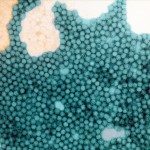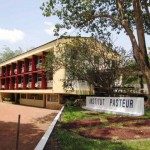About
Human infections by enteroviruses (EVs) are very common, particularly during childhood. Tens of EV types are known to be able to infect humans. In the vast majority of cases, EV infections remain asymptomatic or trigger very mild symptoms; nonetheless, in some cases, acute EV infection can degenerate into severe manifestations (such as poliomyelitis, encephalitis, myocarditis, respiratory diseases etc.) that can be fatal or induce long-lasting sequelae. Therefore, EVs have a considerable impact on human health.
Our main goal is to identify the mechanisms that generate genetic diversity in EV ecosystems and to understand how this diversity promotes the emergence of new virus lineages with modified phenotypic properties.
Our previous works have highlighted a high genetic diversity among the EV ecosystems in central Africa and in Madagascar. Furthermore, these works led to the identification of virus types and lineages that have never been identified elsewhere. Therefore, central Africa and Madagascar appear to host two specific EV ecosystems made of both viruses that circulate worldwide and viruses whose circulation seems to be restricted to central Africa and/or to Madagascar. Yet, our previous works were affected by two limitations: first, we only focused on EVs excreted in stool samples and thus did not consider EVs that mainly replicate in respiratory tract; second, we used established cell lines to isolate EVs from stool samples and thus missed non-cultivable EVs and EVs that do not induce cytopathic effect in cell lines.
In this project, we will use new technologies to uncover the parts of the EV ecosystems that have remained hidden during our previous works, to study the epidemiology of these viruses and to decipher the genetic links they have with other EVs. For this purpose, we plan to perform direct screening of RNA extracted from clinical samples (nasopharyngeal swab and stool samples) and wastewater samples collected in Cameroon, Central African Republic and in Madagascar by using EV-targeting molecular assays. RNA extracted from positive samples will be subsequently used to directly amplify EV genomes and to sequence them using next-generation sequencing technology.
Phylogenetic studies will be conducted to determine how close viruses that circulate in the two considered regions are to viruses identified elsewhere. Because recombination is an important driver of EV evolution, we will also study whether the new populations of EVs uncovered by this work exchange or not genetic sequences with EVs classically observed with standard techniques. We will also detect, quantify and characterize recombination by-products that lead to the generation of defective viral particles whose role in the evolution of EV populations remains unknown.
An important goal is to train partners belonging to the Institut Pasteur International Network (IPIN) to use next-generation sequencing techniques and to analyse raw sequence data generated through these techniques with bioinformatics tools. In the context of the near eradication of polioviruses, we also aim to provide new information about the potential of nasopharyngeal swab samples collected in regions where oral polio vaccine is in use to constitute a source of re-emergence of poliovirus after its future eradication.
Our results will throw new light on the genetic diversity of EVs that infect humans in geographic regions with specific ecosystems in which this diversity is suspected to be peculiarly wide. They will also provide valuable information about the epidemiology of the EVs that were missed by our previous works. These information will help to conceive future studies to determine the impact of these EVs on human health where they circulate.
Besides, this project will improve the ability of the three partners of the IPIN to autonomously use technics based on next-generation sequencing, which constitutes now a key tool for diagnosis, surveillance and control of infectious diseases. As these three partners are on the front line of surveillance systems of many infectious diseases, this project will increase their respective capacity to anticipate and to thwart future emergences of human pathogens in their countries.












